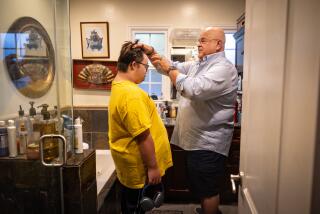MAKING A DIFFERENCE : Visionary Care For Those With Poor Sight
- Share via
Many people think that those who are legally blind see only darkness. In fact, 76% of those who are legally blind have some sight. Since 1978, the Santa Monica-based Center for the Partially Sighted has worked with visually impaired people to give them the vision aids, day-to-day living skills and counseling they need to make the most of their remaining vision and to stay independent. The center is the only low vision rehabilitation facility in Southern California that provides comprehensive services in one location for partially sighted people. The average cost for services at the center is between $500 and $800, but no one is ever turned away for lack of funds.
Some Tips For The Partially Sighted
Some low-tech vision aids--talking clocks and calculators, large-print telephone number pads and playing cards, and raised-print checks--are quite inexpensive. These are available through the center’s store and by catalog order. The center’s staff also suggests no-tech adaptations that enhance independence at home:
Use rubber bands to identify cans: one around vegetable cans, two around fruit.
Increase visibility of pots and pans by striping their handles with contrasting color plastic tape.
Indicate commonly used settings on household items such as toasters, stoves, radios, measuring cups using Hi Marks, a fluorescent gel that dries leaving a brightly colored raised mark.
Drape a contrasting color towel over the edge of the tub to make it easier to see the edge.
Float a brightly colored toy in the bathtub to check the water height during filling.
High-Tech Future
The Low Vision Enhancement System or LVES (pronounced “Elvis”) will be available by prescription in October through the Center for the Partially Sighted in October. The Johns Hopkins University School of Medicine developed the goggles in collaboration with NASA and the U.S. Department of Veterans Affairs. Cameras project video images through two miniature television screens housed in a wrap-around headset. Users of the $5200 unit see images that “look like you’re sitting four feet from a 60-inch big screen television” according to its maker, Minnesota-based Visionics Corp.
Moveable magnification camera enlarges images up to 9 times to read signs at a distance or pick up facial features.
Small video cameras mounted in front of each eye provide a 50-degree horizontal field of view at normal magnification.
Battery pack worn on waist allows user to adjust image’s focus and contrast, switch between normal and zoom lenses, and zoom the magnification camera in and out. The unit can be hooked up to a television or computer to project video images directly into the goggles.
Offering Help
To avoid guessing or worrying that you’ll do too much or too little, the center’s staff suggest that you simply ask partially sighted persons if and what type of help they’d like. A few general guidelines:
Identify yourself verbally each time you greet the person and when you enter or leave the room, as facial recognition may be impossible.
When accompanying persons into an unfamiliar room, escort them to a reference point like a chair or table. Don’t leave them standing alone in the middle of a room.
To help someone into a car, guide the person’s hand to the door handle.
Instead of pointing or gesturing, use descriptive references like “It’s two feet in front of you” and “The office is the first door on your right.”
California’s Visually Impaired Population
By Age
0-19: 4%
20-64: 28%
65 and older: 68%
Source: Center for the Partially Sighted
How It’s Funded
The center’s funding:
33%: local and state governments
15%: fees from services and sales of low-vision devices
52%: donations, special events and grants
To Get Involved
Call the Center for the Partially Sighted (310) 458-3501.
Researched by CATHERINE GOTTLIEB / Los Angeles Times
More to Read
Sign up for Essential California
The most important California stories and recommendations in your inbox every morning.
You may occasionally receive promotional content from the Los Angeles Times.













